| number | 1 | 2 | 3 | 4 | 5 | 6 | 7 | 8 | 9 |
| freqency | 0 | 1 | 5 | 5 | 6 | 4 | 12 | 3 | 3 |
04-Distributions
Applied Statistics – A Practical Course
2025-11-20
Probability Distributions
Definition
- a mathematical function
- probabilities of occurrence of different possible outcomes for an experiment
\(\rightarrow\) https://en.wikipedia.org/wiki/Probability_distribution
Characteristics
- a specific shape (distribution type, a mathematical formula)
- can be described by its parameters (e.g. mean \(\mu\) and standard deviation \(\sigma\)).
Probability distributions are one of the core concepts in statistics and many statistics courses start with coin tossing1 or dice rolls. We begin with a small classroom experiment.
What is your favorite number?
In a classroom experiment, students of an international course were asked for their favorite number from 1 to 9.
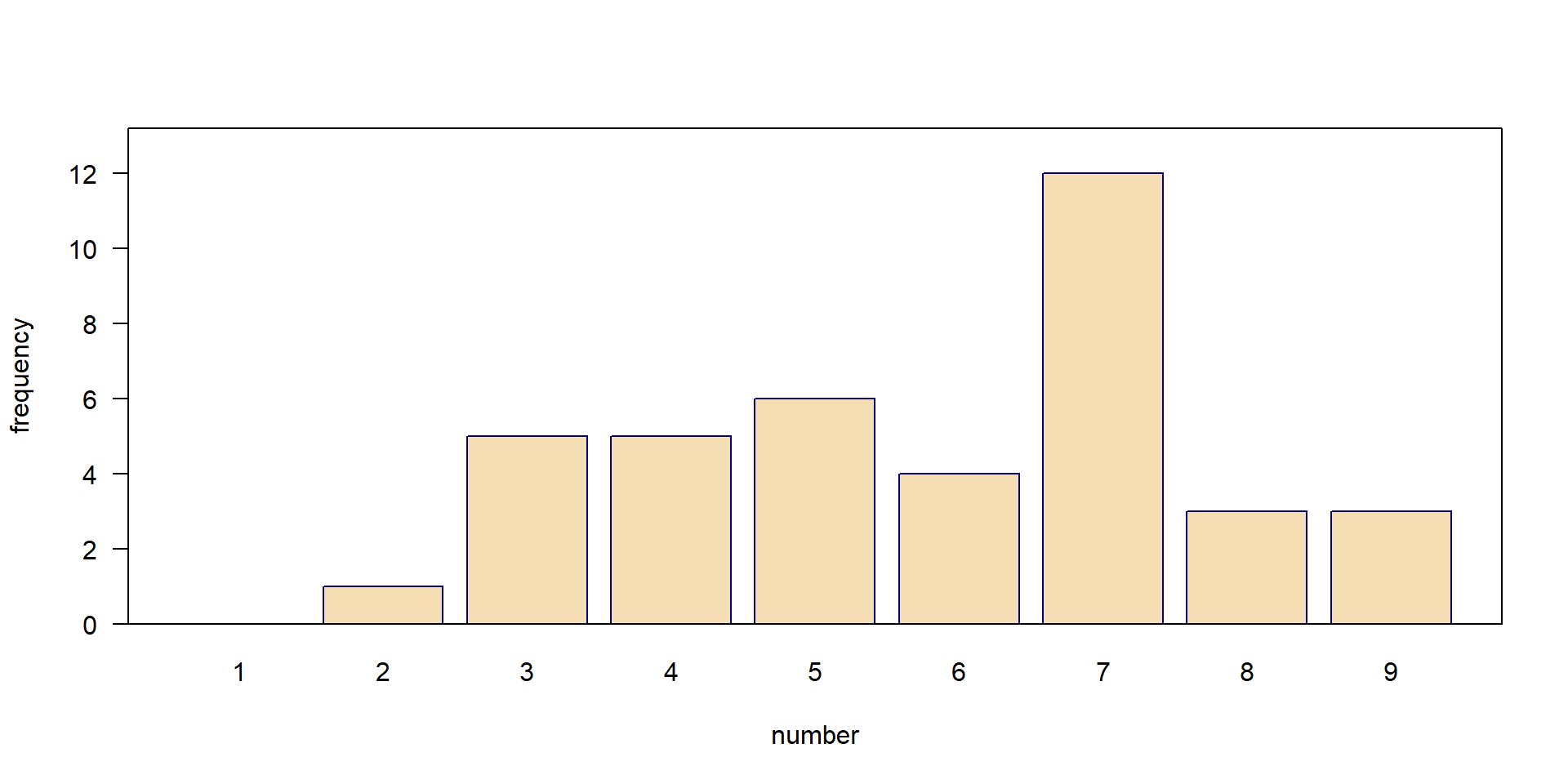
The resulting distribution is:
- empirical: data from an experiment
- discrete: only discrete numbers (1, 2, 3 …, 9) possible, no fractions
Computer simulations
Instead of real-world experiments, we can also use simulated random numbers.
- advantage: we can simulate data from distributions with known properties
- challenge: somewhat abstract
Purpose
- get a feeling about randomness, how a sample following a given “theory” can look like
- explore and test statistical methods and train understanding
- a tool for experimental design
- testing application and power of an analysis beforehand
\(\rightarrow\) Simulation: important tool for statistical method development and understanding!
Continuos uniform distribution \(\mathbf{U}(0, 1)\)
- same probability of occurence in a given interval
- e.g. \([0, 1]\)
- in R:
runif, random, uniform
[1] 0.5114425 0.1479786 0.4758420 0.4116042 0.8703237 0.1085770 0.1970274
[8] 0.8633014 0.9360339 0.5007363
- binning: subdivide values into classes
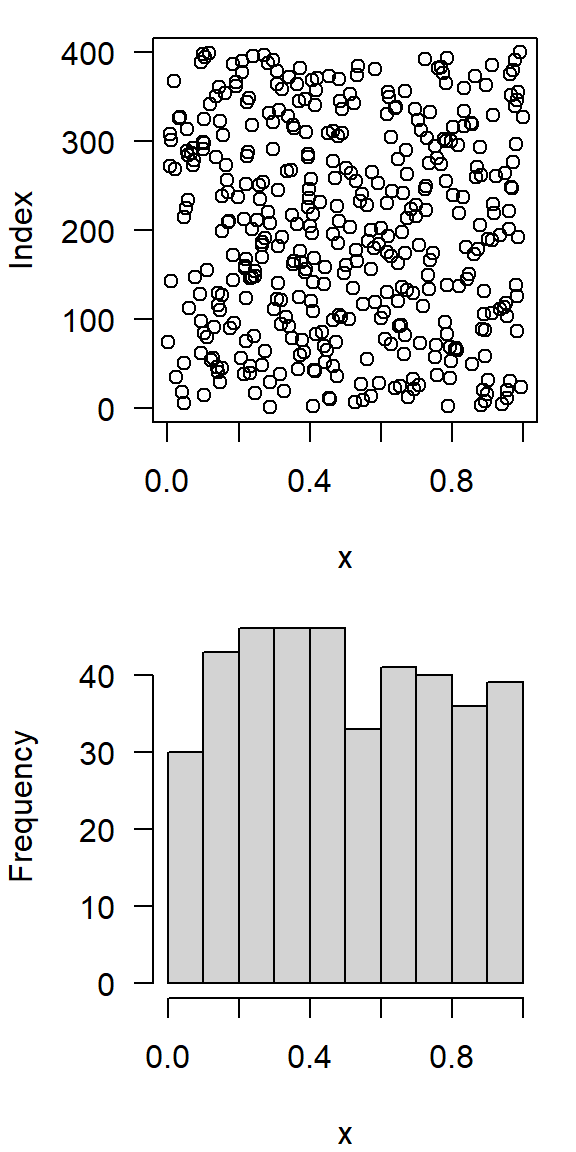
Density function of \(\mathbf{U}(x_{min}, x_{max})\)
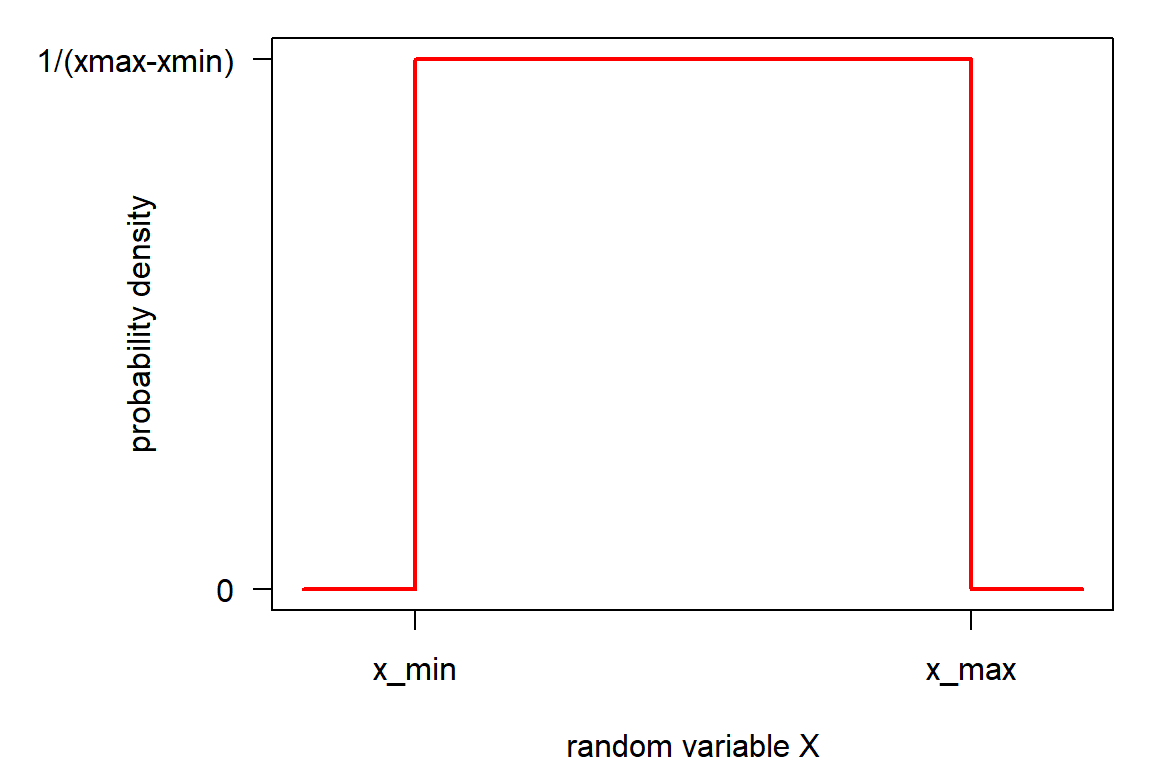
- density \(f(X)\), sometimes abbreviated as “pdf” (probability density function):
\[ f(x) = \begin{cases} \frac{1}{x_{max}-x_{min}} & \text{for } x \in [x_{min},x_{max}] \\ 0 & \text{otherwise} \end{cases} \]
- area under the curve (i.e. the integral) = 1.0
- 100% of the events are between \(-\infty\) and \(+\infty\)
and for \(\mathbf{U}(x_{min}, x_{max})\) in the interval \([x_{min}, y_{max}]\)
Cumulative distribution function of \(\mathbf{U}(x_{min}, x_{max})\)
The cdf is the integral of the density function:
\[ F(x) =\int_{-\infty}^{x} f(x) dx \] The total area (total probability) is \(1.0\):
\[ F(x) =\int_{-\infty}^{+\infty} f(x) dx = 1 \]
For the uniform distribution, it is:
\[ F(x) = \begin{cases} 0 & \text{for } x < x_{min} \\ \frac{x-x_{min}}{x_{max}-x_{min}} & \text{for } x \in [x_{min},x_{max}] \\ 1 & \text{for } x > x_{max} \end{cases} \]
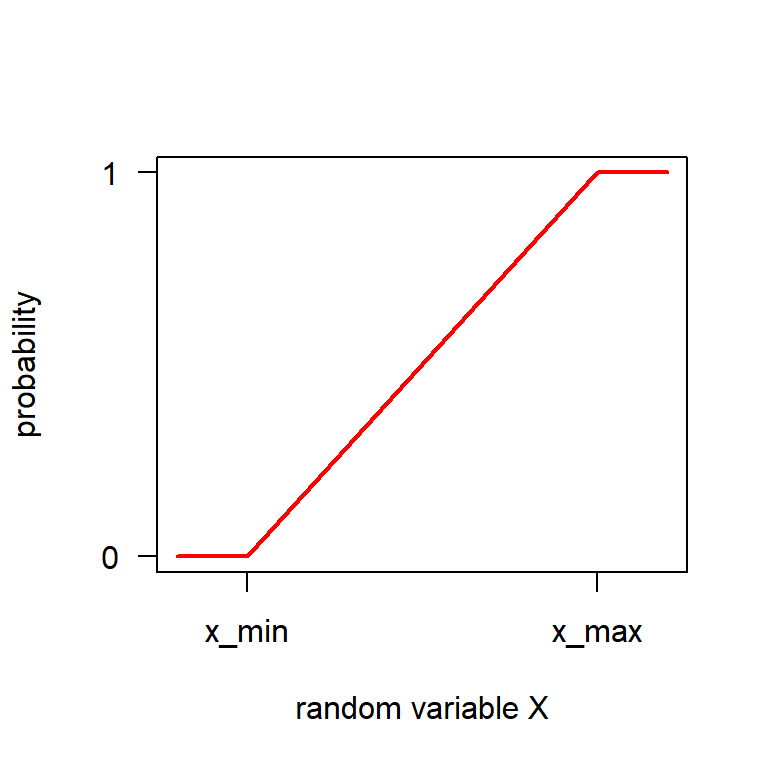
Quantile function
… the inverse of the cumulative distribution function.

Cumulative distribution function
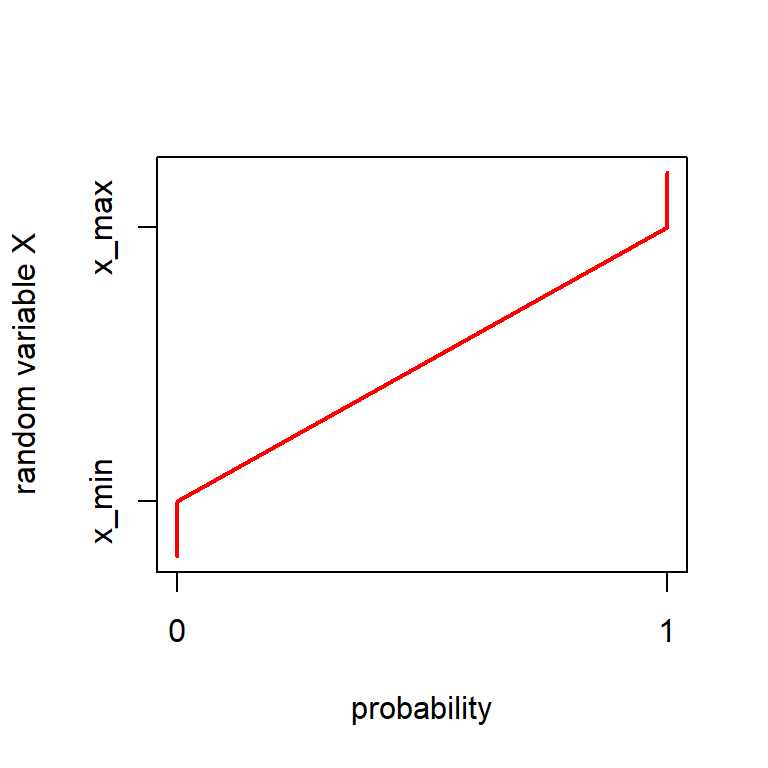
Quantile function
Example: In which range can we find 95% of a uniform distribution \(\mathbf{U}(40,60)\)?
Summary: Uniform distribution
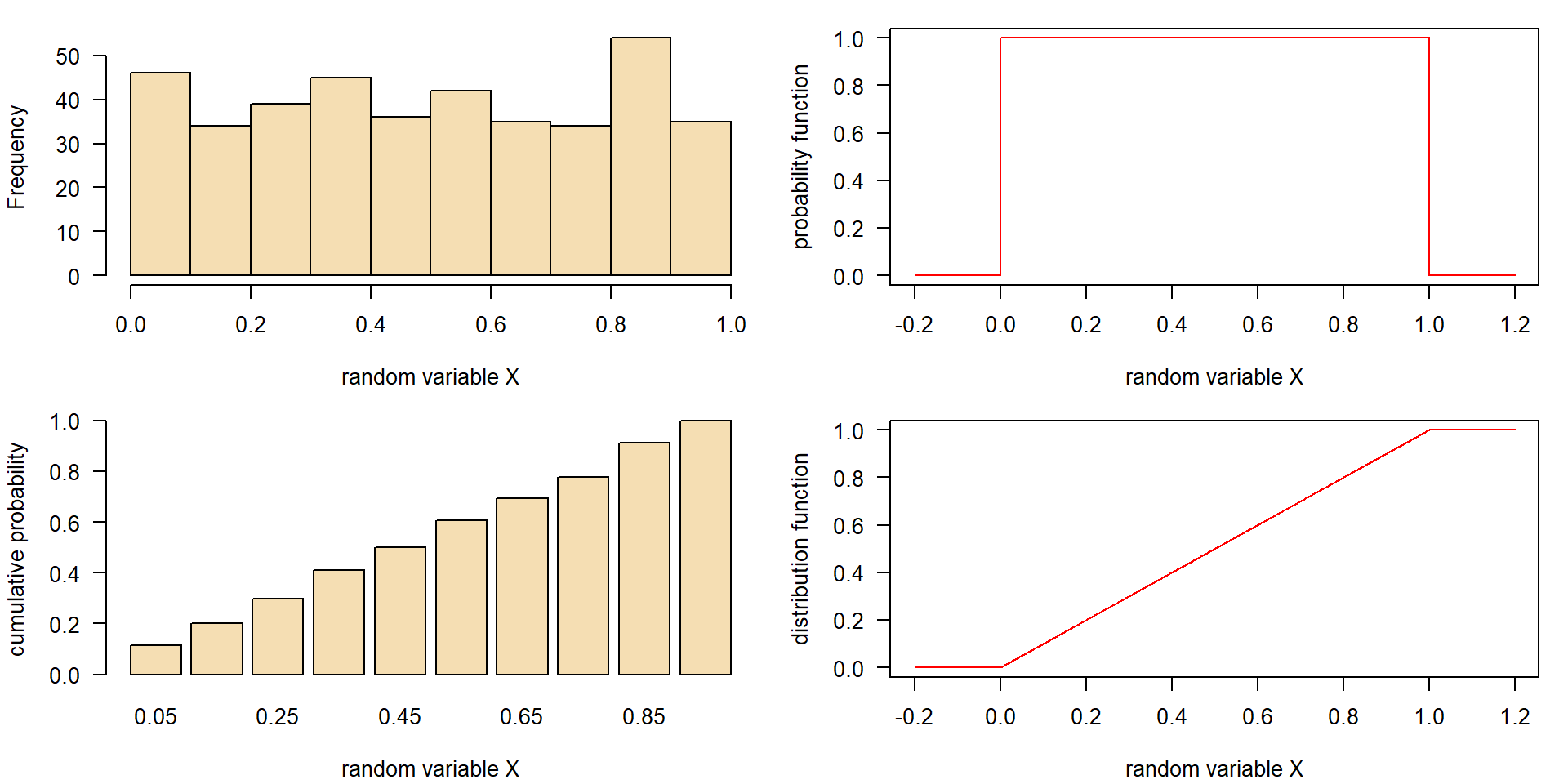
The normal distribution
The normal distribution \(\mathbf{N}(\mu, \sigma)\)
- of high theoretical importance due to the central limit theorem (CLT)
- results from adding a large number of random values of same order of magnitude.
The density function of the normal distribution is mathematically beautiful.
\[ f(x) = \frac{1}{\sigma\sqrt{2\pi}} \, \mathrm{e}^{-\frac{(x-\mu)^2}{2 \sigma^2}} \]
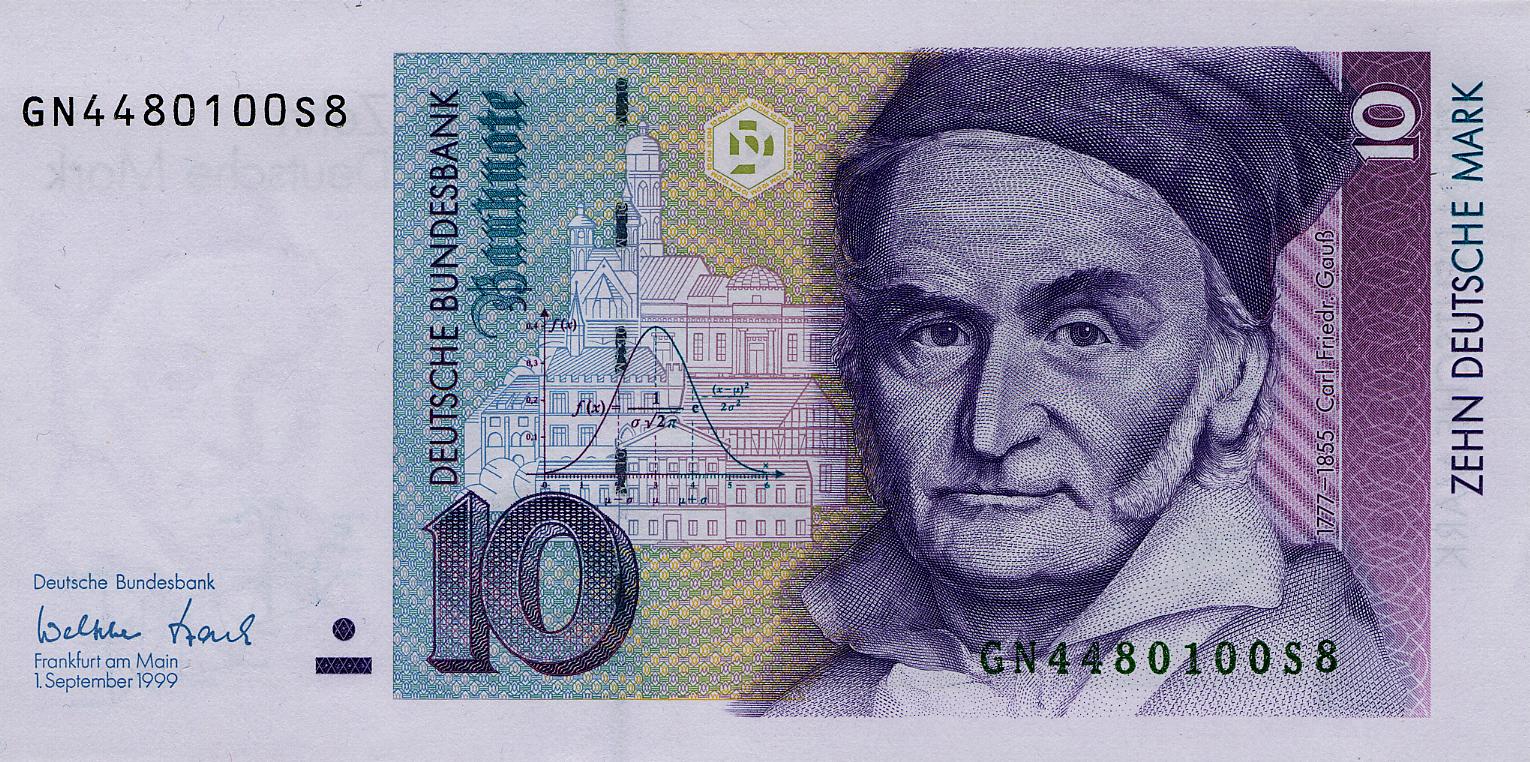
C.F. Gauss, Gauss curve and formula on a German DM banknote from 1991–2001 (Wikipedia, CC0)
The central limit theorem (CLT)
Sums of a large number \(n\) of independent and identically distributed random values are normally distributed, independently on the type of the original distribution.

A Simulation experiment
- generate a matrix with 100 rows and 25 columns of uniformly distributed random numbers
- compute the row sums
\(\rightarrow\) row sums are approximately normal distributed
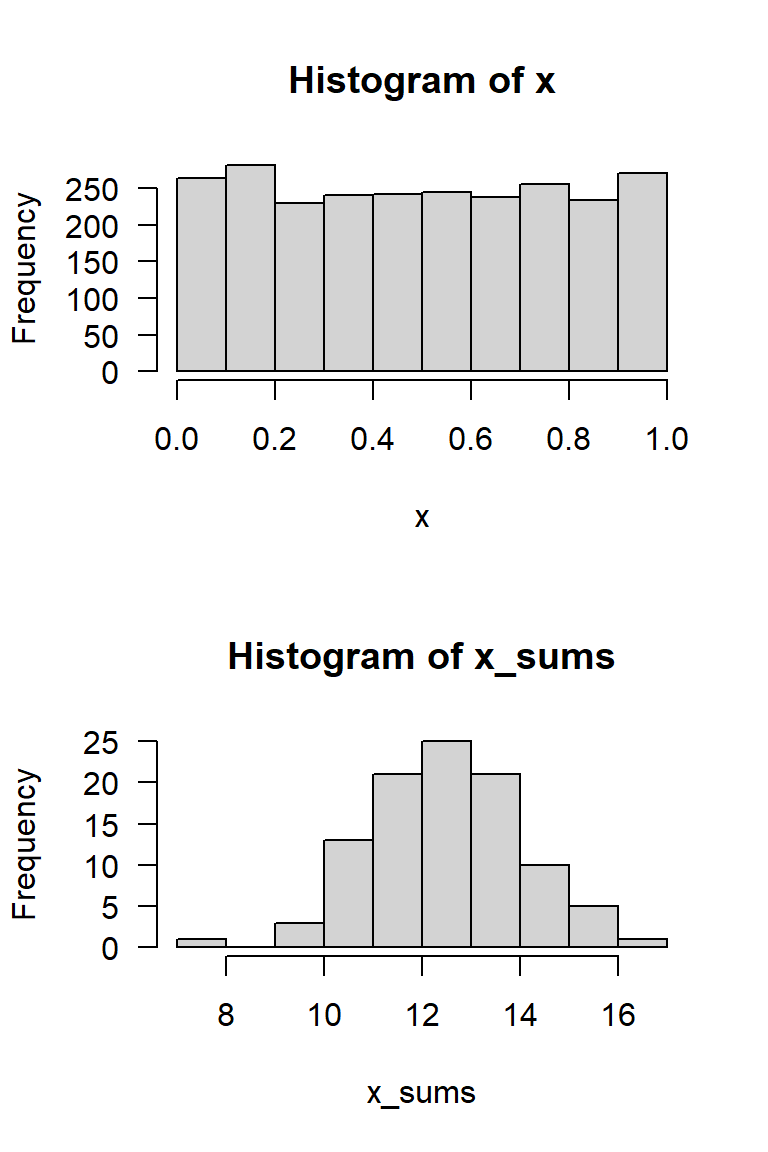
Random numbers and density function
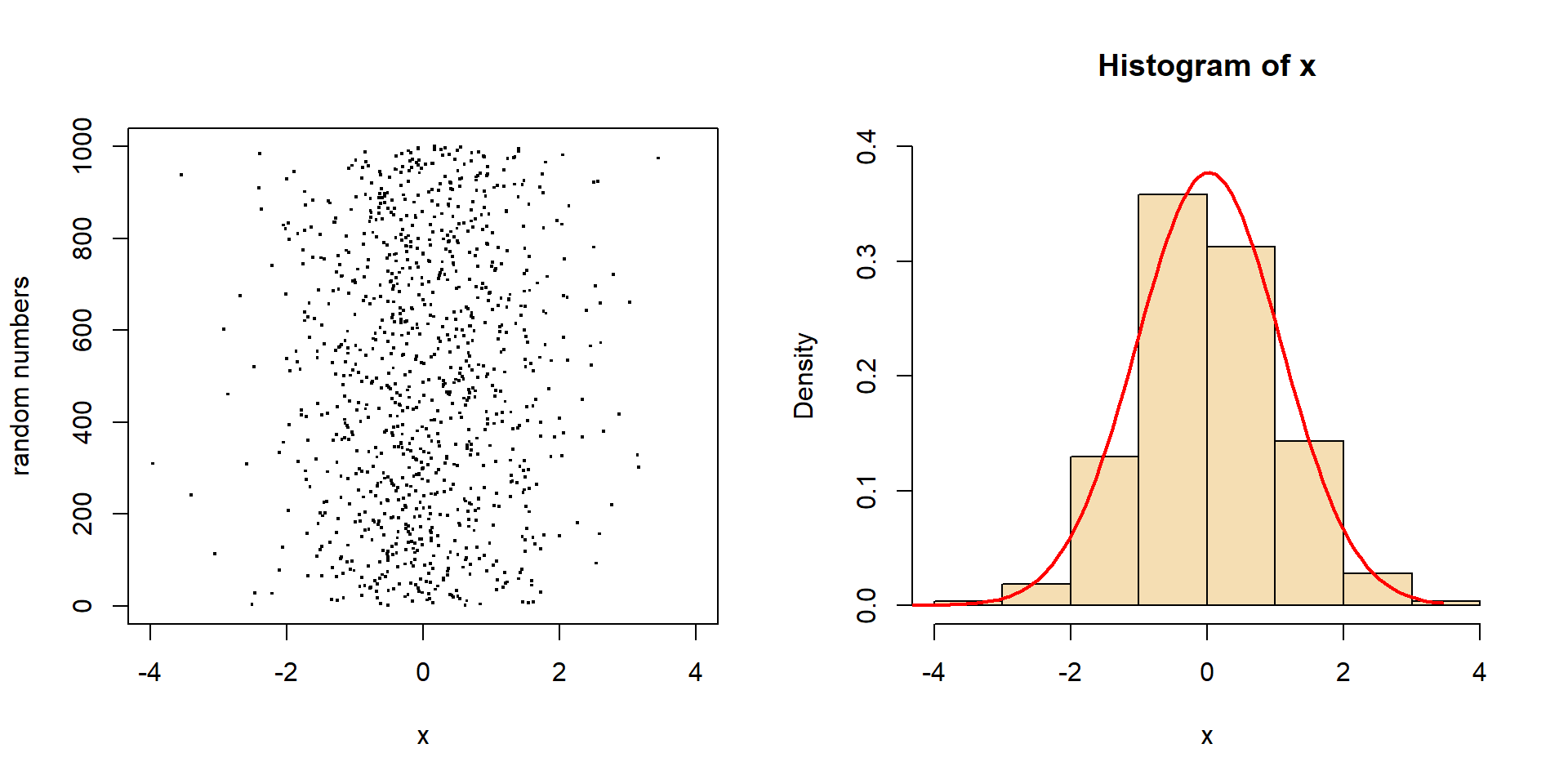
Density and quantiles of the standard normal
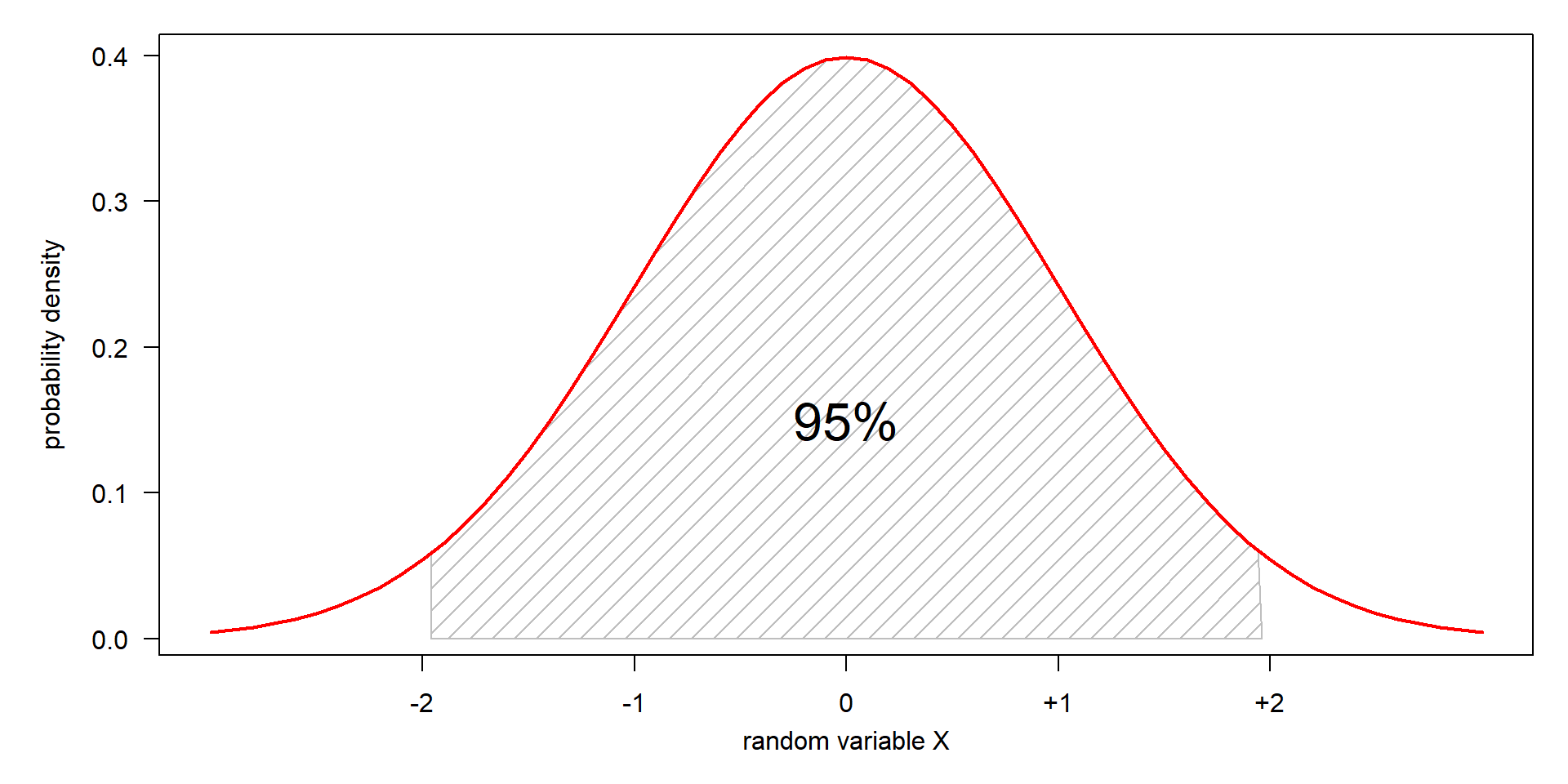
- in theory, 50% of the values are below and 50% above the mean value
- 95% are between \(\pm 2 \sigma\)
Density and quantiles of the standard normal
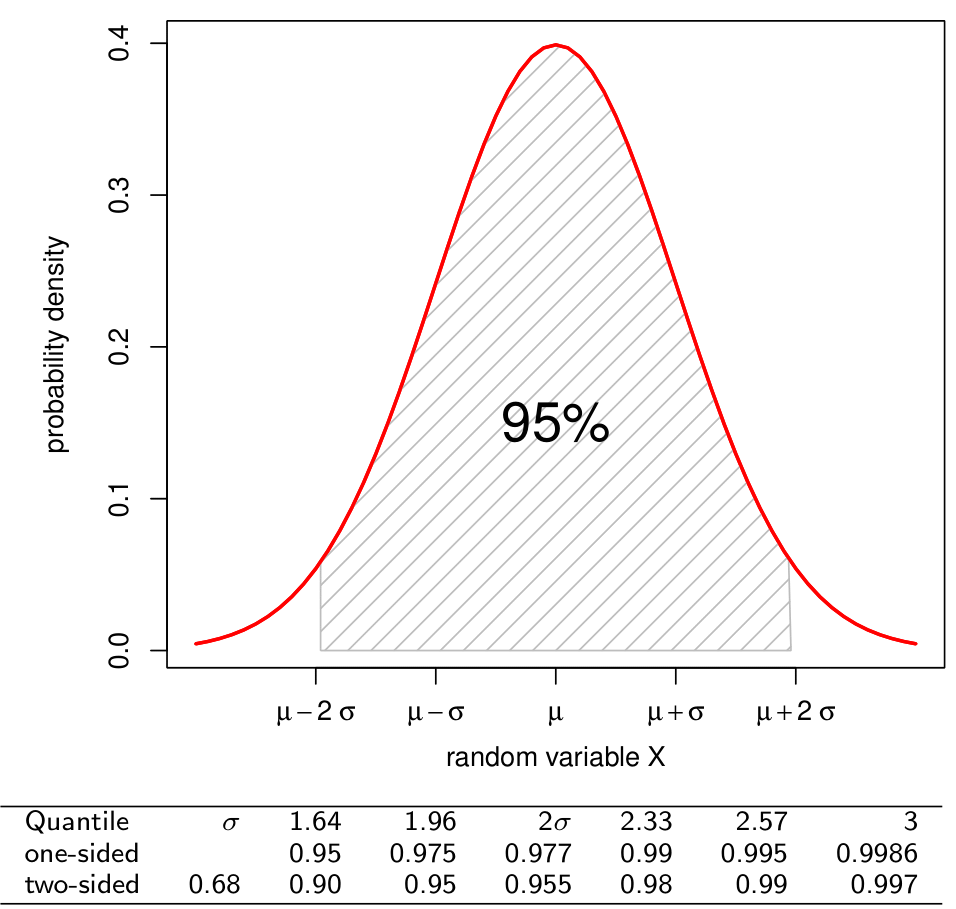
Cumulative distribution function – Quantile function
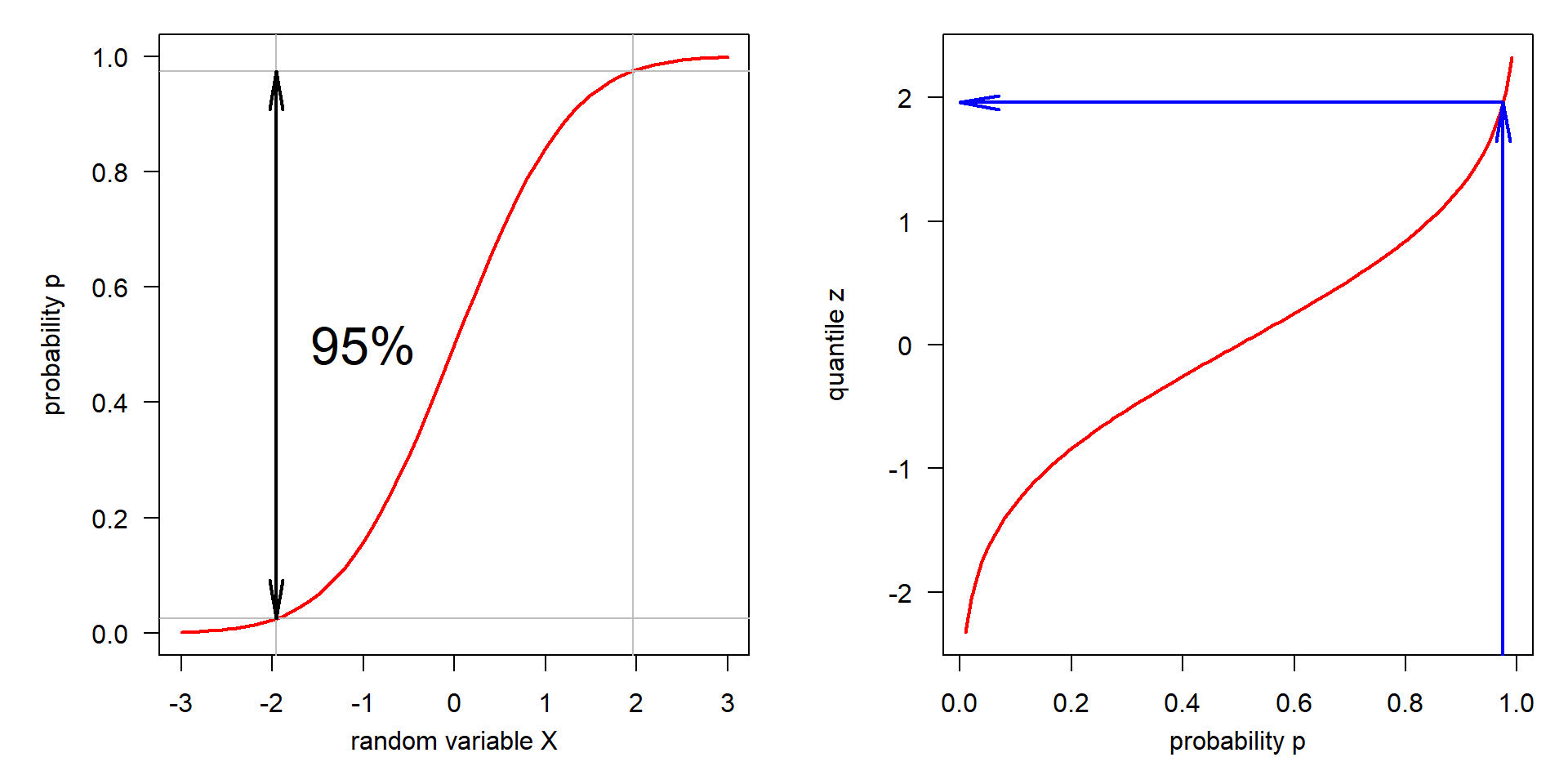
| Quantile | 1 | 1.64 | 1.96 | 2.0 | 2.33 | 2.57 | 3 | \(\mu \pm z\cdot \sigma\) |
|---|---|---|---|---|---|---|---|---|
| one-sided | 0.95 | 0.975 | 0.977 | 0.99 | 0.995 | 0.9986 | \(1-\alpha\) | |
| two-sided | 0.68 | 0.90 | 0.95 | 0.955 | 0.98 | 0.99 | 0.997 | \(1-\alpha/2\) |
Standard normal, scaling and shifting
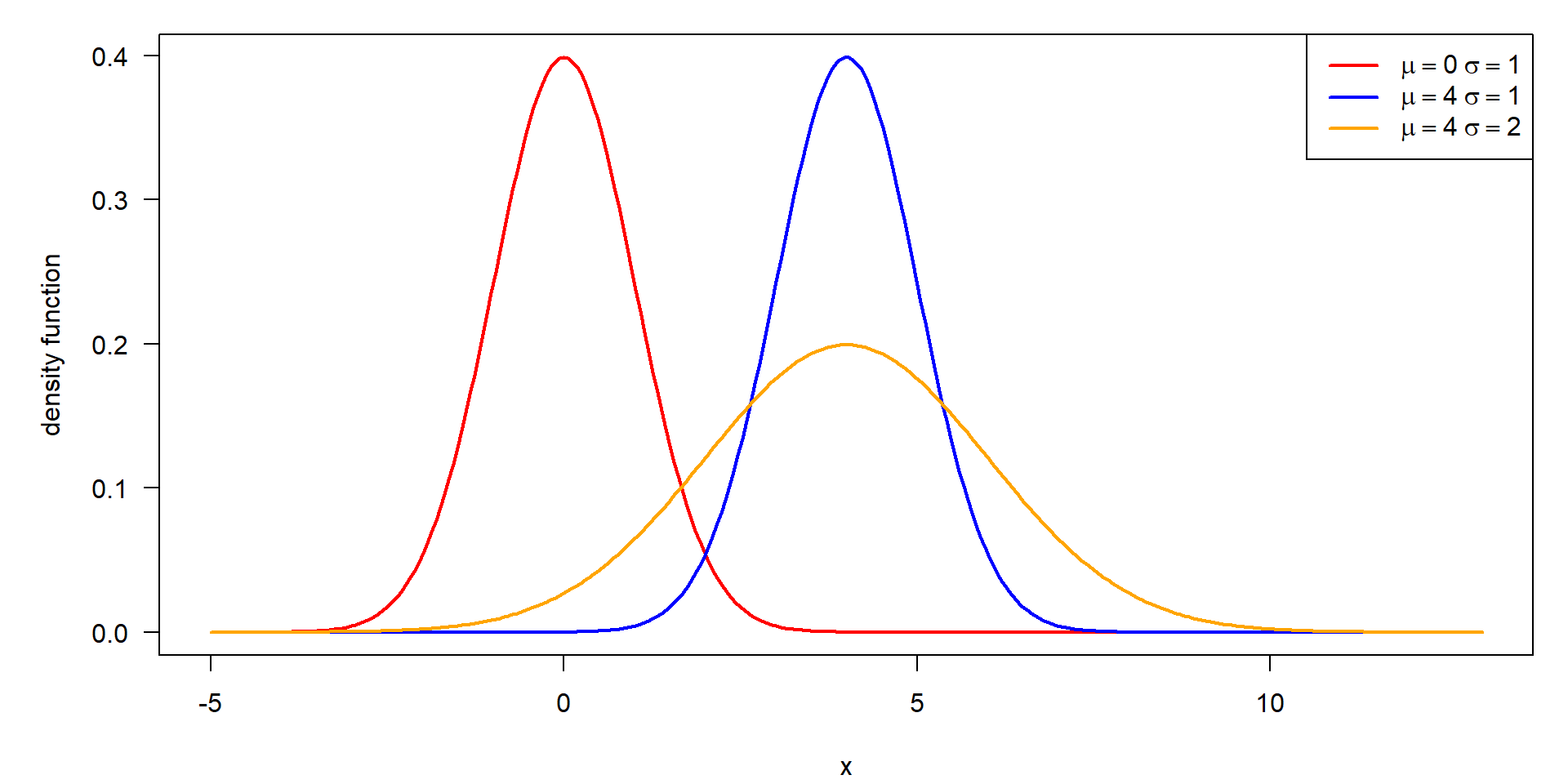
- \(\mu\) is the shift parameter that moves the whole bell shaped curve along the \(x\) axis
- \(\sigma\) is the scale parameter to stretch or compress in the direction of \(x\)
Standardization (\(z\)-transformation)
Any normal distribution can be shifted scaled to form a standard normal with \(\mu=0, \sigma=1\)
Normal distribution
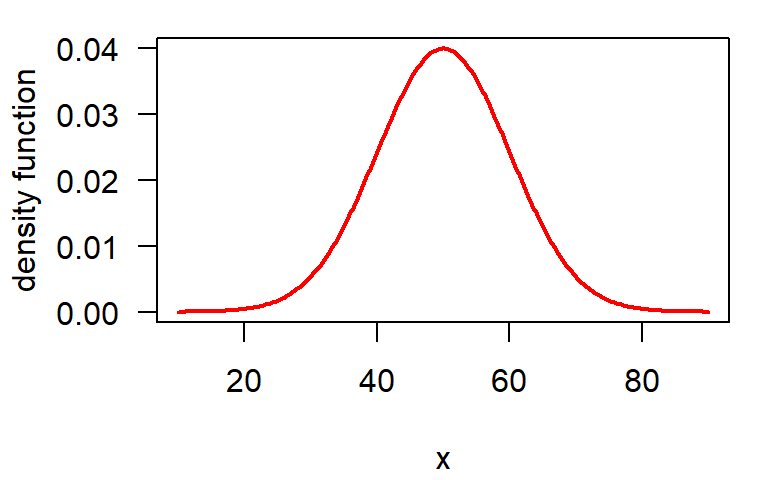
\[ f(x) = \frac{1}{\sigma\sqrt{2\pi}} \, \mathrm{e}^{-\frac{(x-\mu)^2}{2 \sigma^2}} \]
\[
z = \frac{x-\mu}{\sigma}
\] \(\longrightarrow\) \(\longrightarrow\) \(\longrightarrow\)
Standard normal distribution
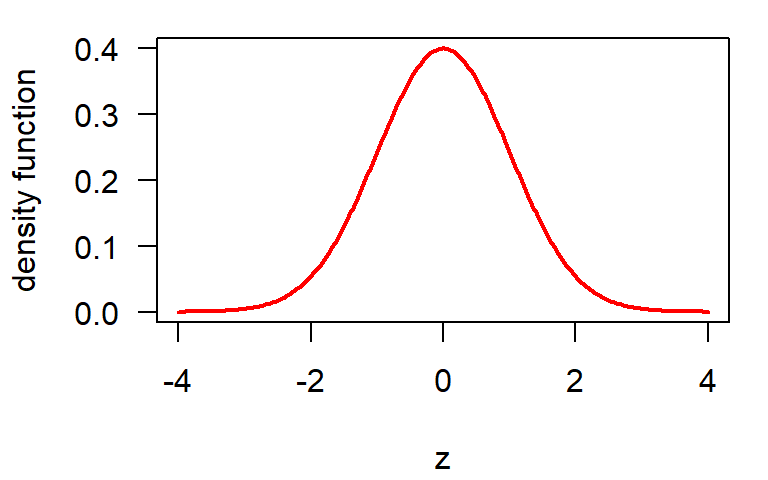
\[ f(x) = \frac{1}{\sqrt{2\pi}} \, \mathrm{e}^{-\frac{1}{2}x^2} \]
t-Distribution \(\mathbf{t}(x, df)\)
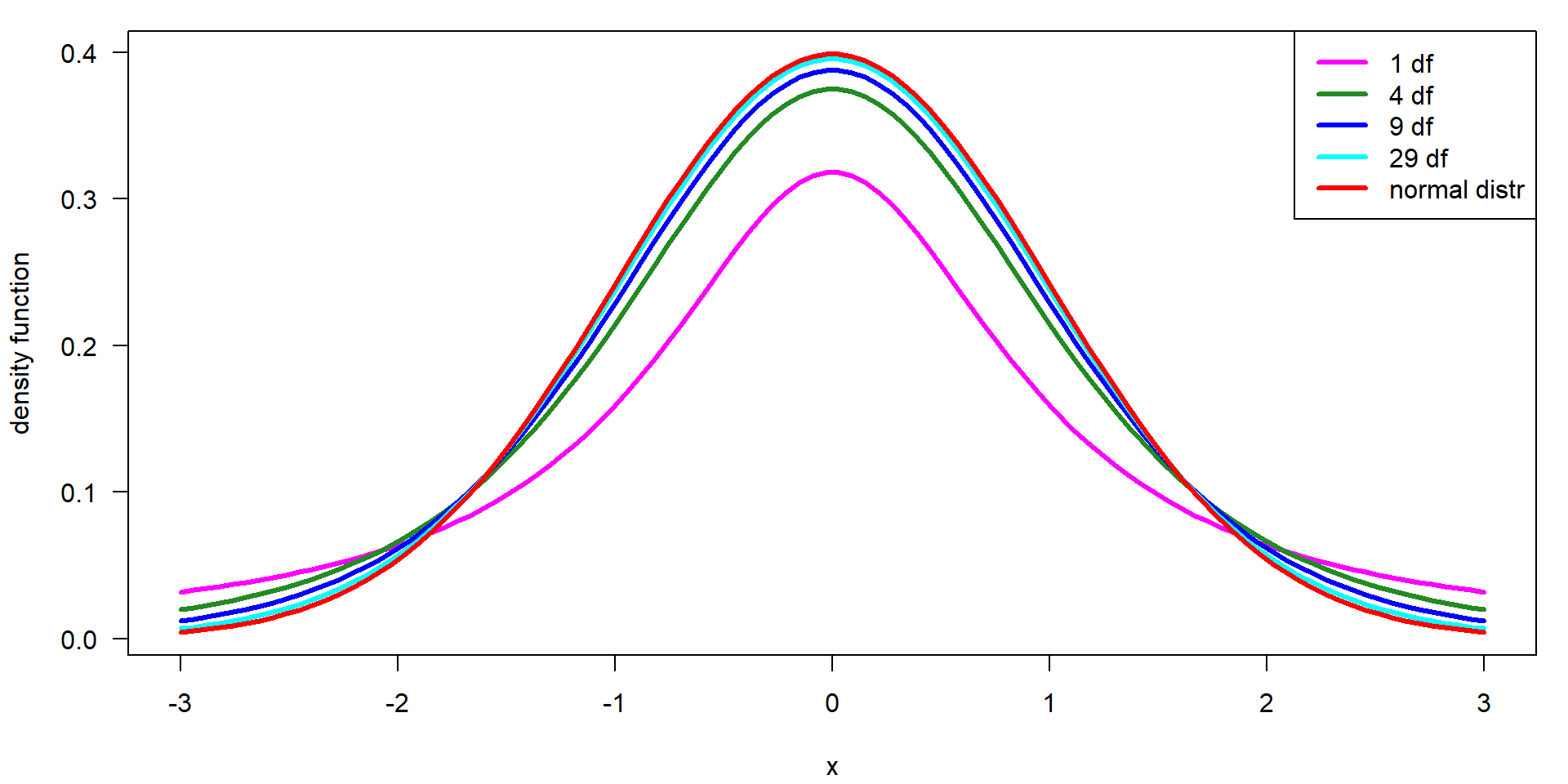
- additional parameter “degrees of freedom” (df)
- used for confidence intervals and statistical tests
- converges to the normal distribution for \(df \rightarrow \infty\)
Dependency of the t-value on the number of df
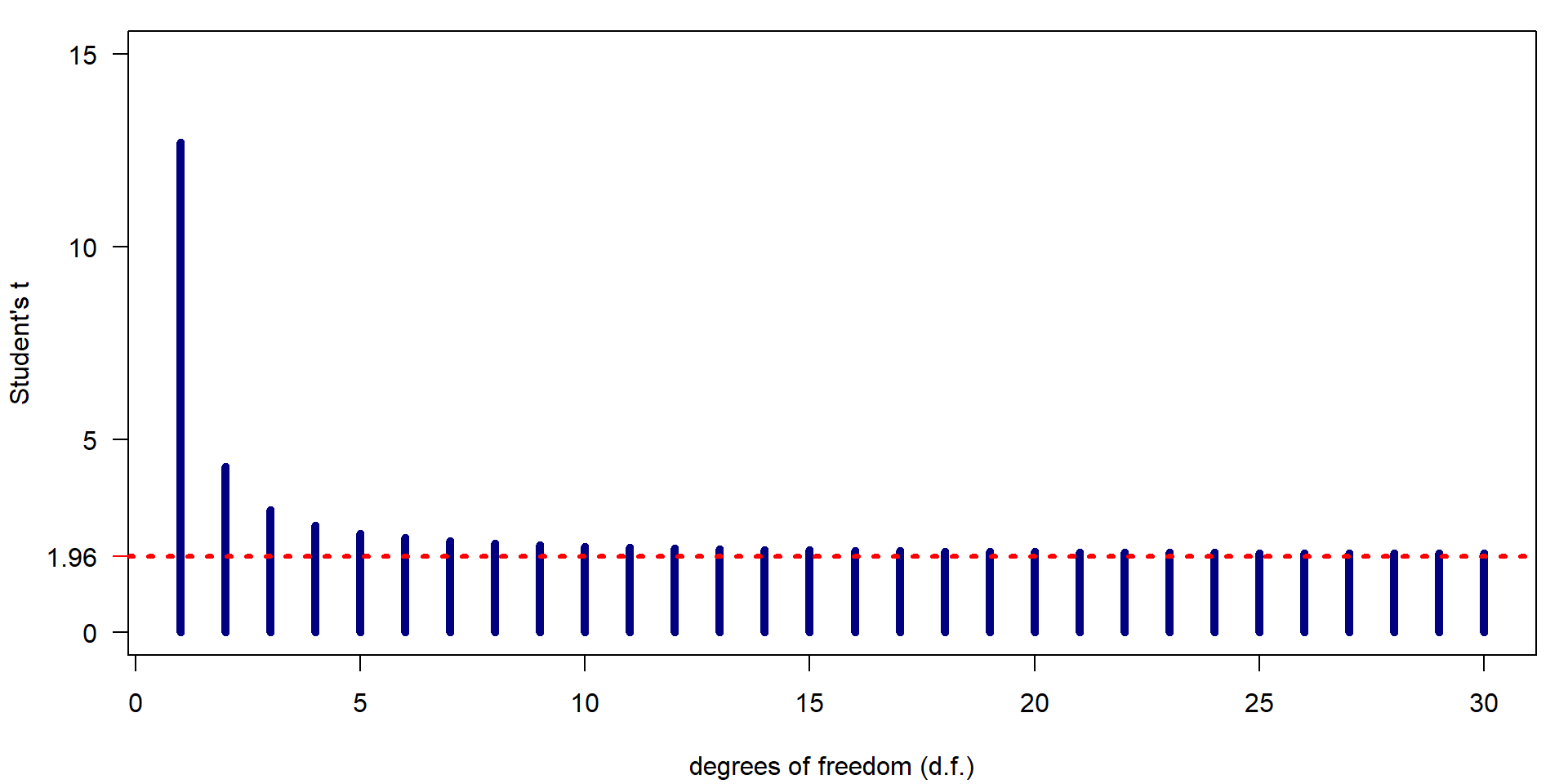
| df | 1.00 | 4.00 | 9.00 | 19.00 | 29.00 | 99.00 | 999.00 |
| t | 12.71 | 2.78 | 2.26 | 2.09 | 2.05 | 1.98 | 1.96 |
Logarithmic normal distribution (lognormal)
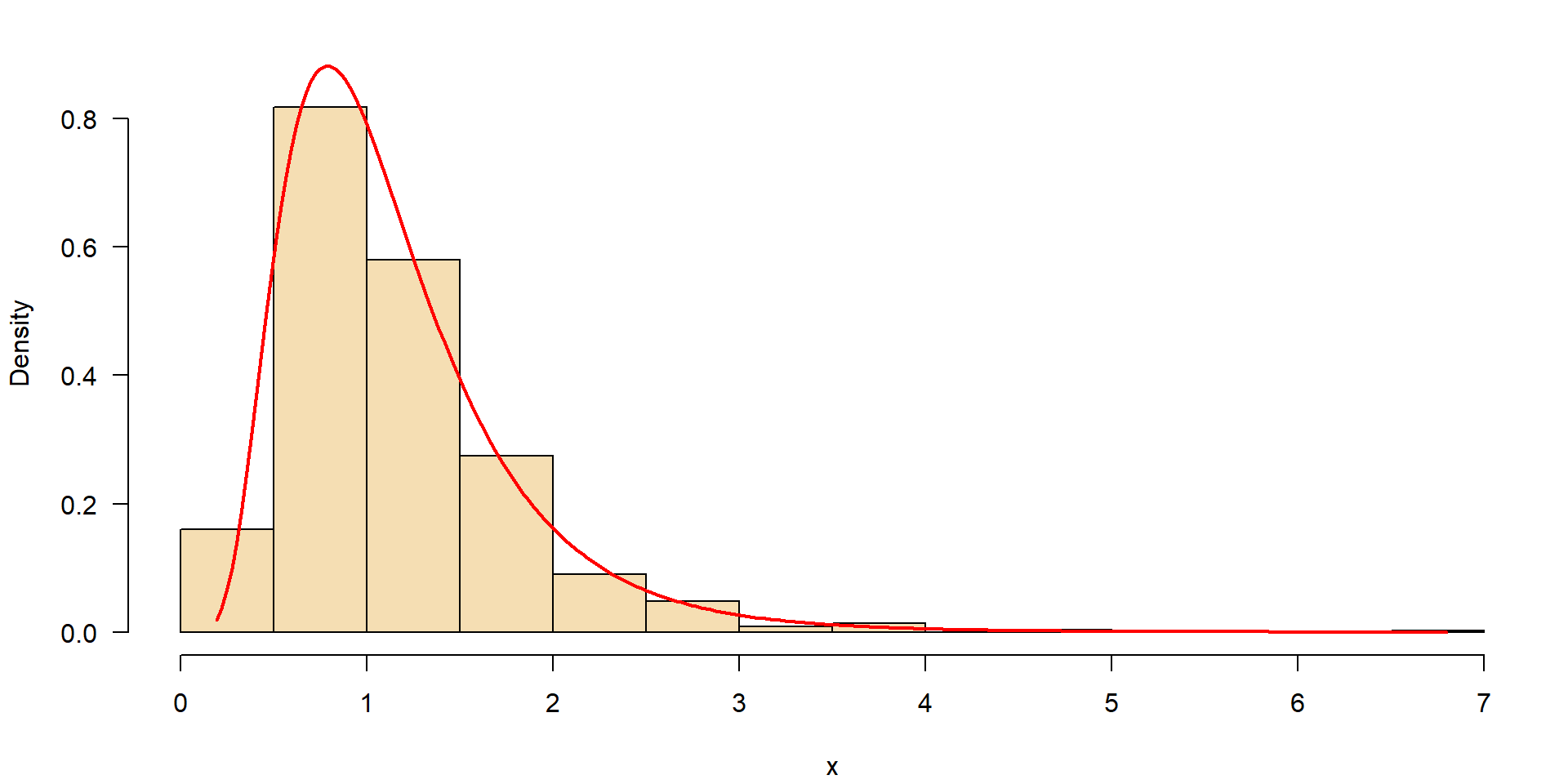
- many processes in nature do not follow a normal distribution
- limited by zero on the left side
- large extreme values on the right side
Examples: discharge of rivers, nutrient concentrations, algae biomass in a lakes
Parent distribution of the lognormal
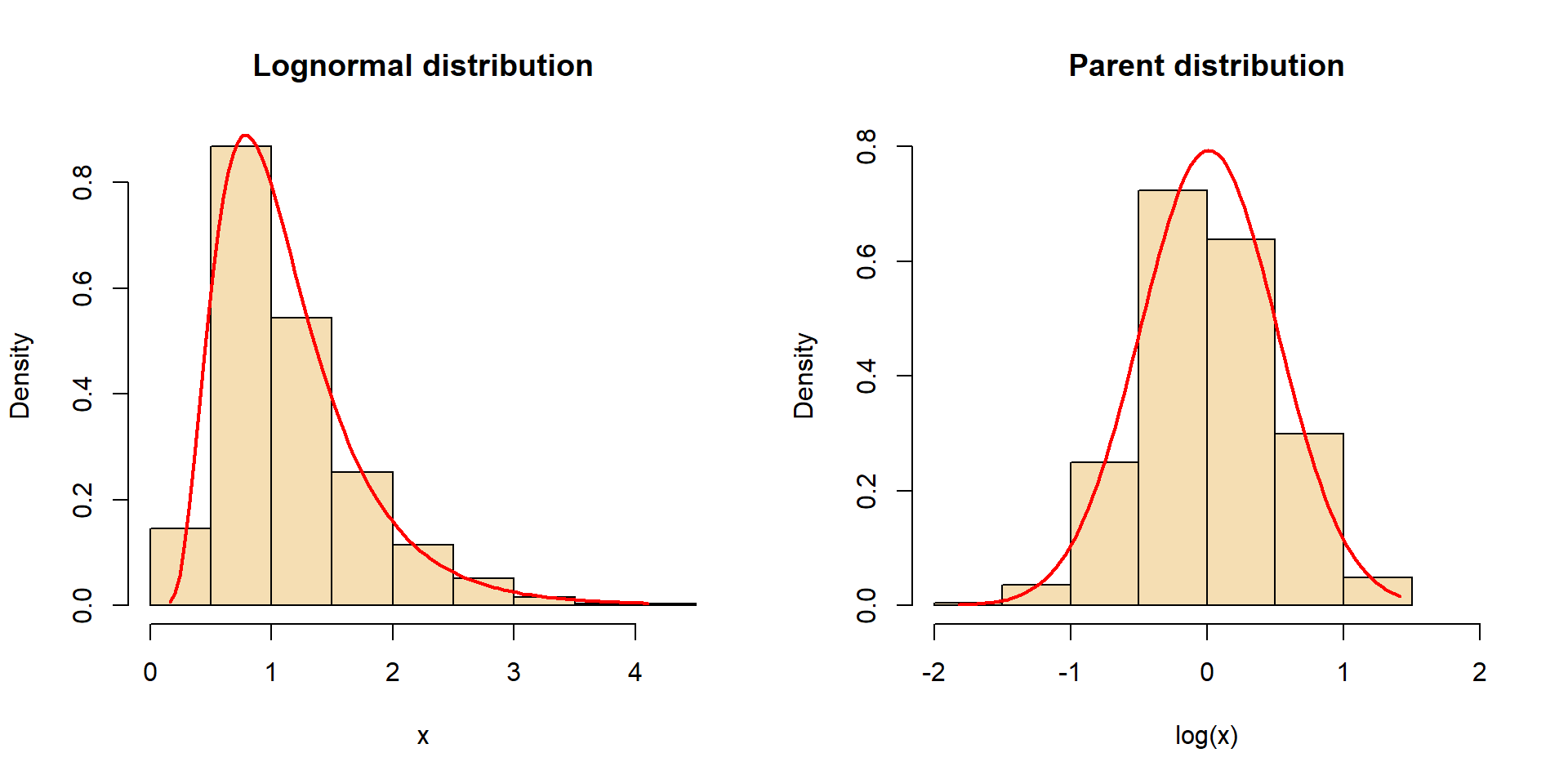
- log from values of a lognormal distribution \(\rightarrow\) normal parent distribution.
- lognormal distribution is described by parameters of log-transformed data \(\bar{x}_L\) and \(s_L\)
- the the antilog of \(\bar{x}_L\) is the geometric mean
Binomial distribution
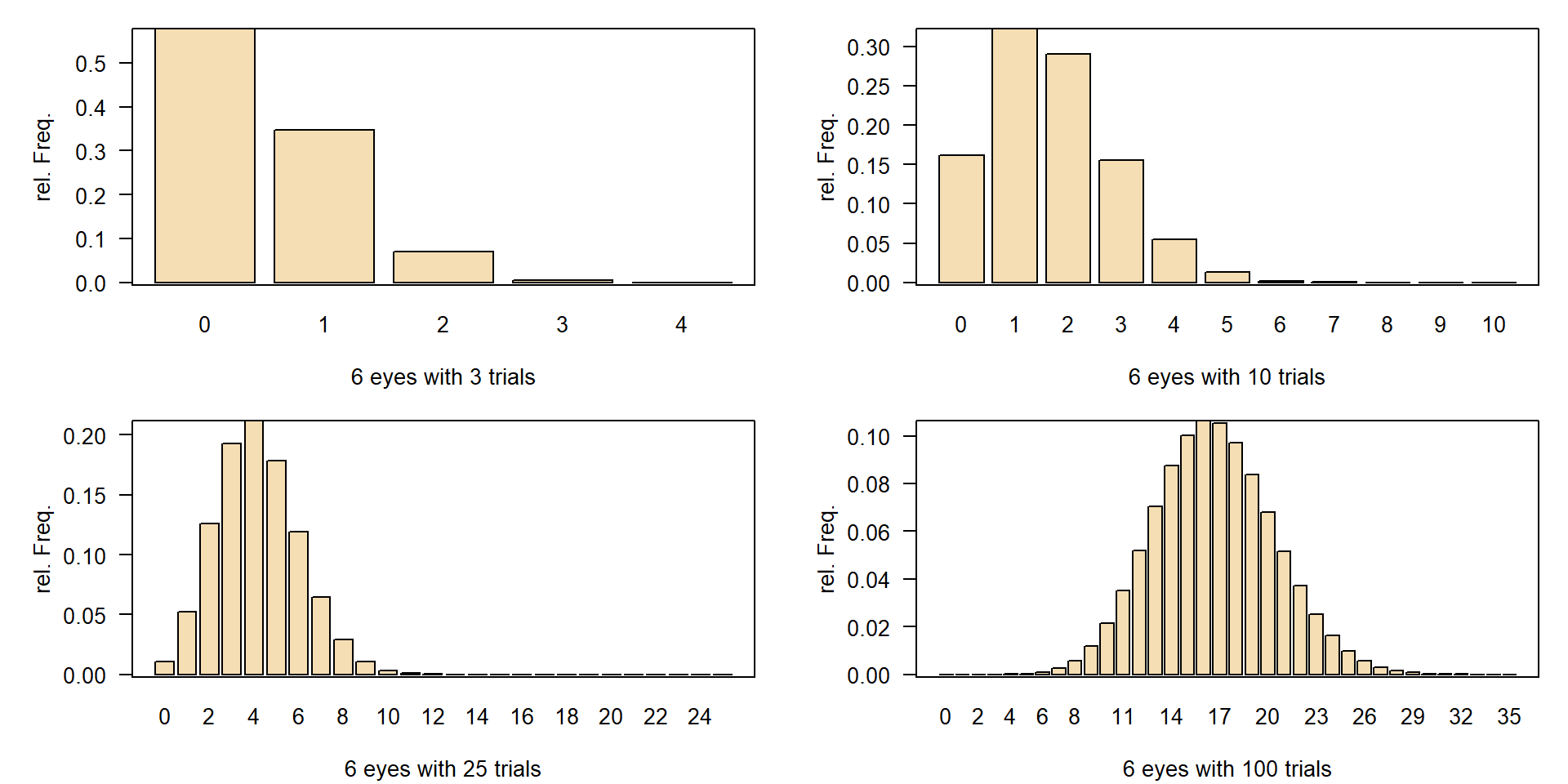
- number of successful trials out of \(n\) total trials with success probability \(p\).
- How many “6” with probability \(1/6\) in 3 trials?
- medicine, toxicology, comparison of percent numbers
- similar, but without replacement: hypergeometric distribution in lottery
Poisson distribution
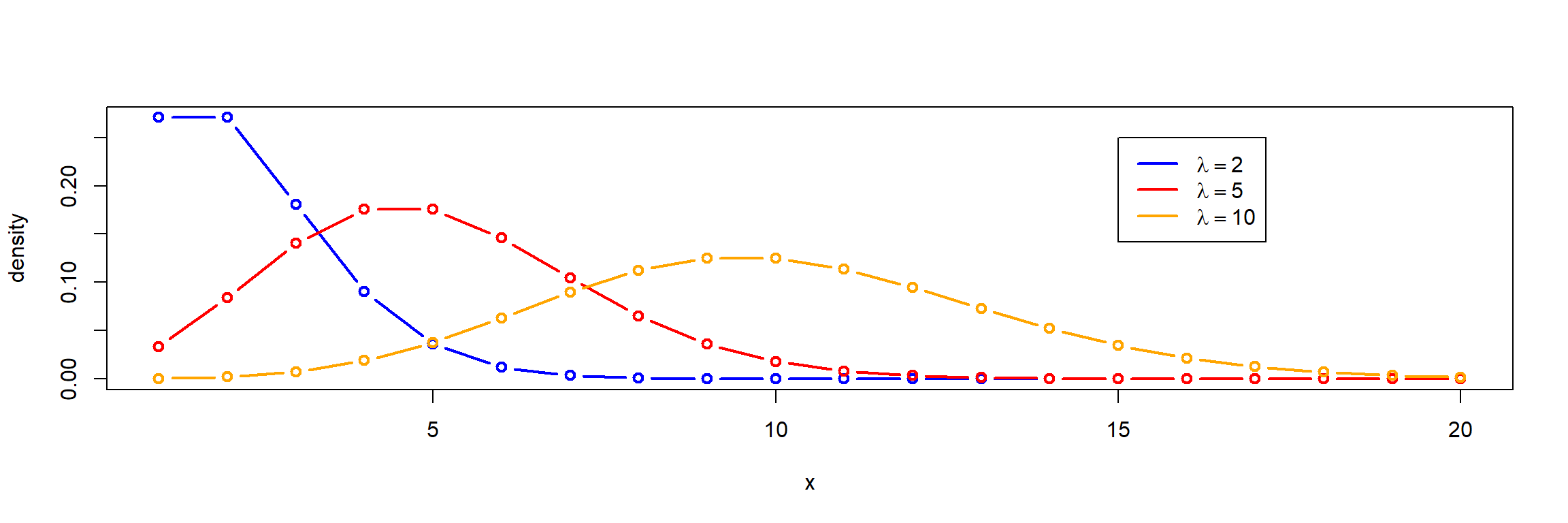
- distribution of rare events, a discrete distribution
- mean and variance are equal (\(\mu = \sigma^2\)), resulting parameter “lambda” (\(\lambda\))
- Examples: bacteria counting on a grid, waiting queues, failure models
Quasi-poisson if \(\mu \neq \sigma^2\)
- If \(s^2 > \bar{x}\): overdispersion
- if \(s^2 < \bar{x}\): underdispersion
Confidence interval
– depends only on \(\lambda\) resp. the number of counted units (\(k\))
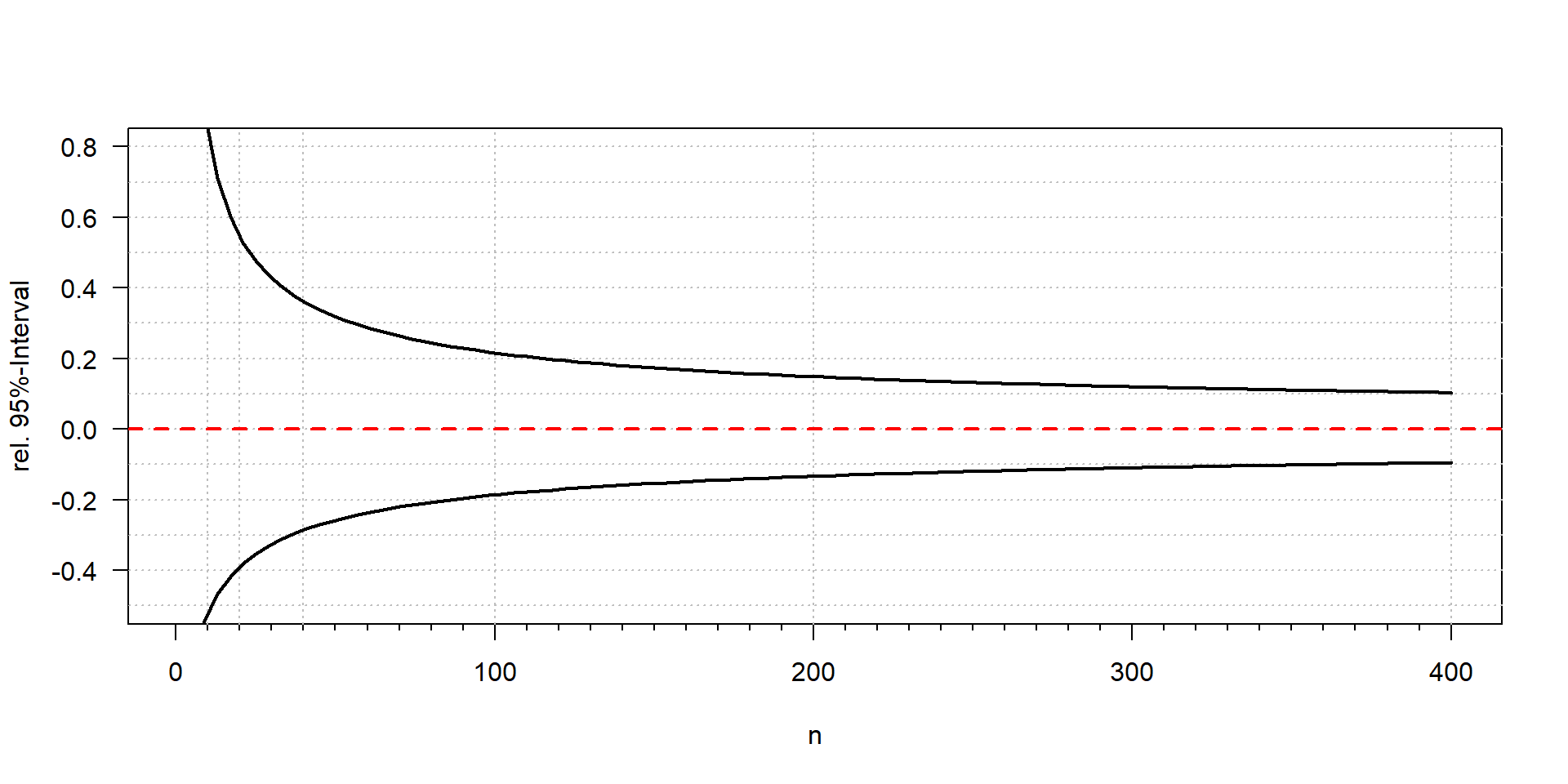
Typical error of cell counting: 95% confidence interval
| counts | 2 | 3 | 5 | 10 | 50 | 100 | 200 | 400 | 1000 |
| lower | 0 | 1 | 2 | 5 | 37 | 81 | 173 | 362 | 939 |
| upper | 7 | 9 | 12 | 18 | 66 | 122 | 230 | 441 | 1064 |
Confidence Intervals
Remember: The central limit theorem (CLT)
Sums of a large number \(n\) of independent and identically distributed random values are normally distributed, independently on the type of the original distribution.
- we can use methods assuming normal normal distribution for non-normal data
- if we have a large data set
- if the original distribution is not “too skewed”
- required number \(n\) depends on the skewness of the original distribution

Reason: Methods like t-test or ANOVA are based on mean values.
Confidence intervals of the mean
Standard error
\[ s_{\bar{x}} = \frac{s}{\sqrt{n}} \]
- variability of the mean is half, if we increase the sample size four times (\(2^2\))
Estimation of the 95% confidence interval:
\[ CI_{95\%} = \bigg(\bar{x} - z_{0.975} \cdot \frac{s}{\sqrt{n}}, \bar{x} + z_{0.975} \cdot \frac{s}{\sqrt{n}}\bigg) \]
with \(z_{1-\alpha/2} = z_{0.975} =\) \(1.96\).
\(\rightarrow\) \(2\sigma\) rule
- interval in which the true mean is found with 95% probability
Difference between sample and confidence intervals
prediction interval: characterizes the distribution of the data from the parameters of the sample (e.g. mean, standard deviation). It estimates the range where a single, future observation will likely fall.
standard deviation \(s_x\) measures the variability of the original data
reconstruct the original distribution if its type is known (e.g. normal, lognormal)
confidence interval: characterizes the precision of a statistical parameter, based on its standard error
Using \(\bar{x}\) and \(s_\bar{x}\), estimate the interval where we find \(\mu\) with a certain probability
less dependent on the original distribution of the data due to the CLT
Use the t-distribution for small samples
\[ CI_{95\%} = \bigg(\bar{x} - t_{0.975, n-1} \cdot \frac{s}{\sqrt{n}}, \bar{x} + t_{0.975, n-1} \cdot \frac{s}{\sqrt{n}}\bigg) \]
- necessary for small samples: \(n\lessapprox 30\), \(n-1\) degrees of freedom
- can also be used for \(n>30\)
- \(t\)-quantile can be found in tables or calculated with the
qt()function in R.
Example with \(\mu=50\) and \(\sigma=10\):
set.seed(123)
n <- 10
x <- rnorm(n, 50, 10)
m <- mean(x); s <- sd(x)
se <- s/sqrt(n)
# lower and upper confidence limits
m + qt(c(0.025, 0.975), n-1) * se[1] 43.92330 57.56922\(\rightarrow\) the true mean (\(\mu\)=50) is in the interval CI = (43.9, 57.6).
Outliers
- extremely large or extremely small values are sometimes called “outliers”
- but, potential outliers can be “extreme values” from a skewed distribution. Excluding them, can be scientific misconduct.
- a “true” outlier is a value that is not from the population we want to analyze, e.g. a serious measurement error if someone forgot to add a chemical in an analysis.
- it can also be something interesting, e.g. the result of new phenomenon
\(\Rightarrow\) It can be wrong to exclude values only because they are “too big” or “too small”.
\(\rightarrow\) Try to find the reason, why values are extreme!
\(4 \sigma\)-rule
- check if a value is more that 4 standard deviations away from the mean value.
- sample size should be \(n \ge 10\), \(\bar{x}\) and \(s\) are calculated without the potential outlier.
- similar “rules of thumb” can be found in statistics textbooks.
Outlier test for linear models with Bonferroni correction
- For linear models and GLMs we can use the Bonferroni outlier test from package car.
library(car)
x <- c(rnorm(20), 12) # the 21st value (=12) is an outlier
outlierTest(lm(x~1)) # x ~ 1 is the null model rstudent unadjusted p-value Bonferroni p
21 11.66351 4.1822e-10 8.7826e-09\(\rightarrow\) The 21st value is identified as an outlier:
Alternative to outlier tests
- use robust parameters and methods,
- e.g. median or trimmed mean instead of the arithmetic mean,
- robust linear regression
rlminstead oflm - rank-based methods like Spearman correlation
- Important outliers may be omitted in an analysis, but the the number and extent of outliers must be mentioned!
Extreme values in boxplots
extreme values outside the whiskers if more than 1.5 times distant from the box limits, compared to the width of the interquartile box.
sometimes called “outliers”.
I prefer the term “extreme value”, because they can be regular observations from a skewed or heavy tailed distribution.
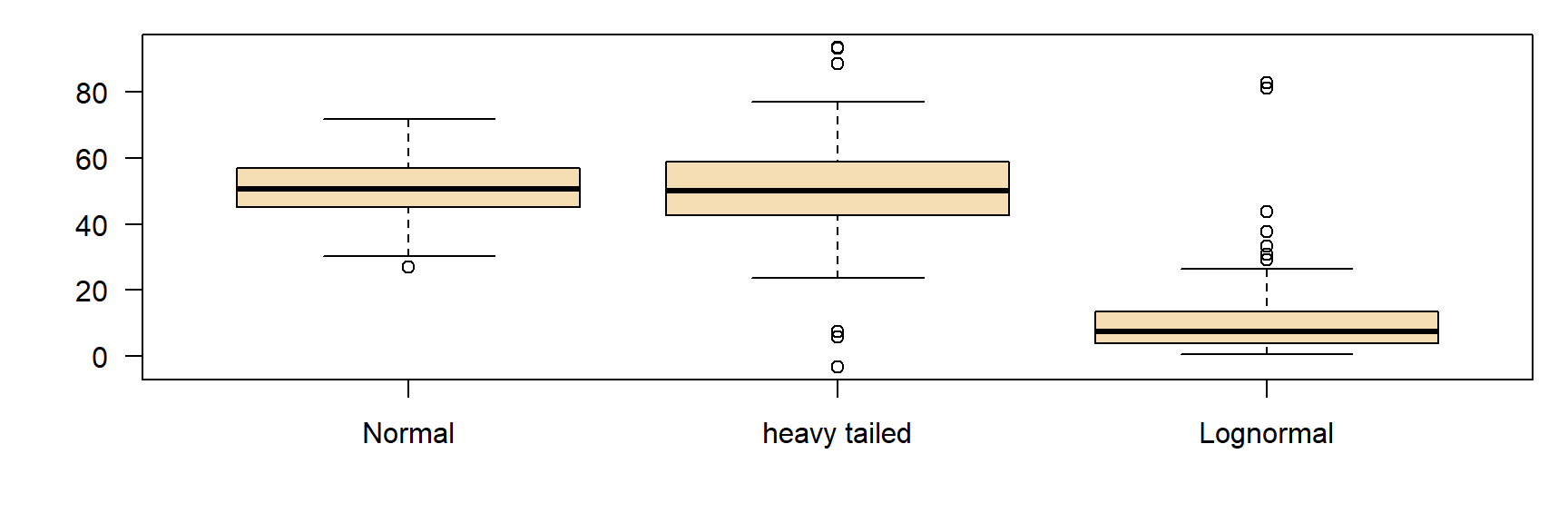
Example
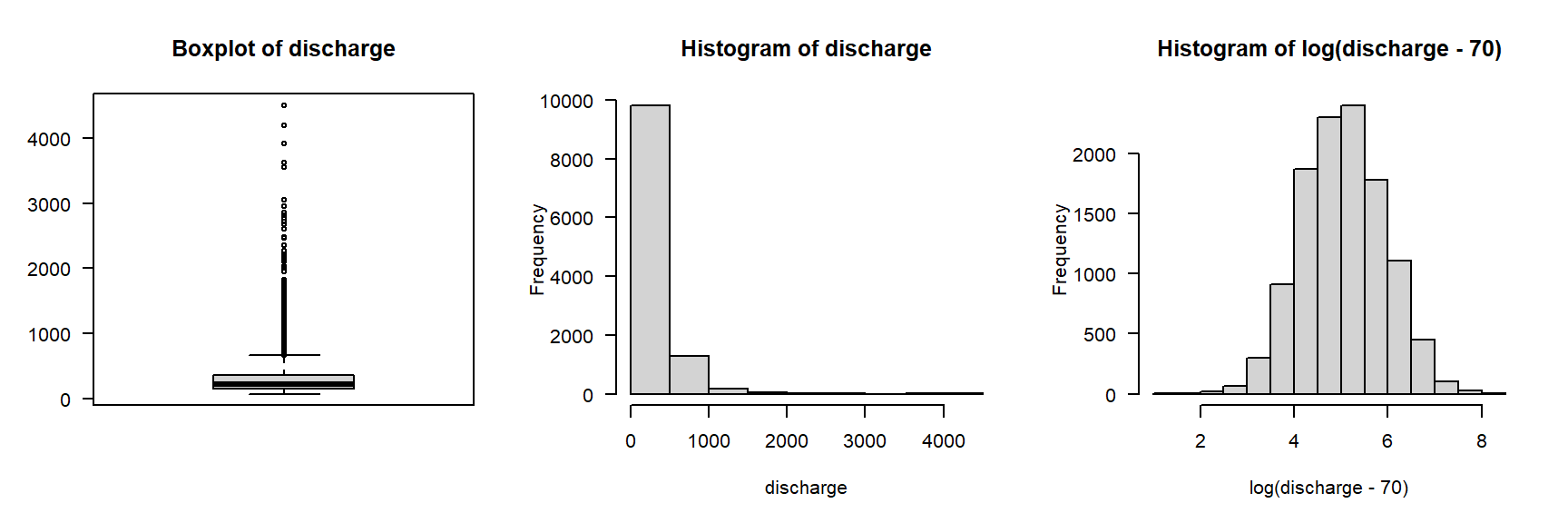
Discharge data of the Elbe River in Dresden in \(\mathrm m^3 s^{-1}\), data source: Bundesanstalt für Gewässerkunde (BFG), see terms and conditions.
- left: large number of extreme values, are these outliers?
- middle: distribution is right-skewed
- right: transformation (3-parametric lognormal) \(\rightarrow\) symmetric distribution, no outliers!